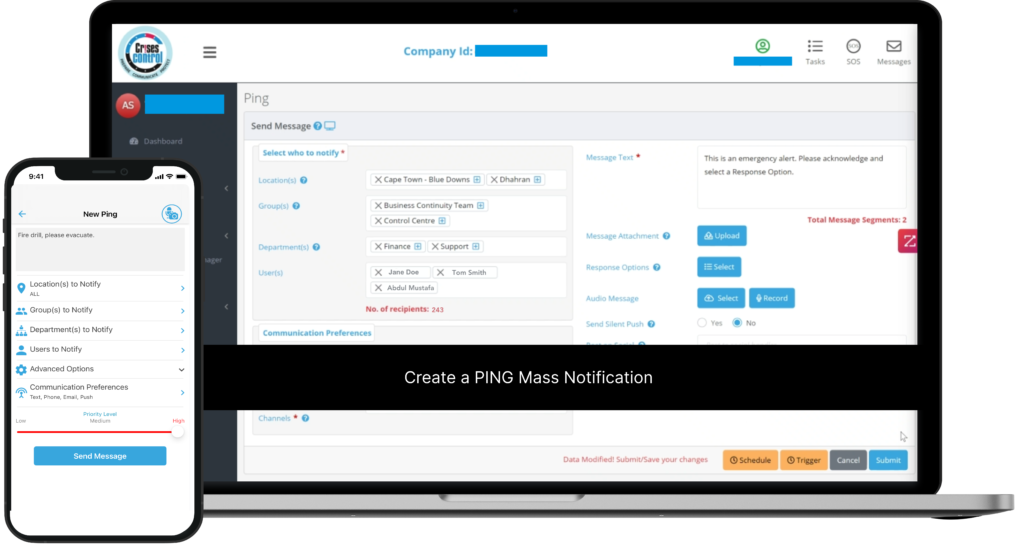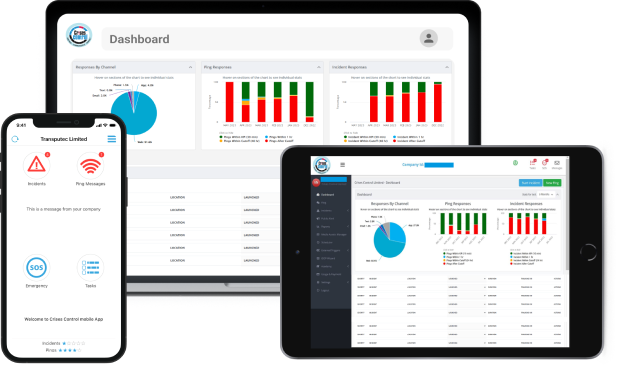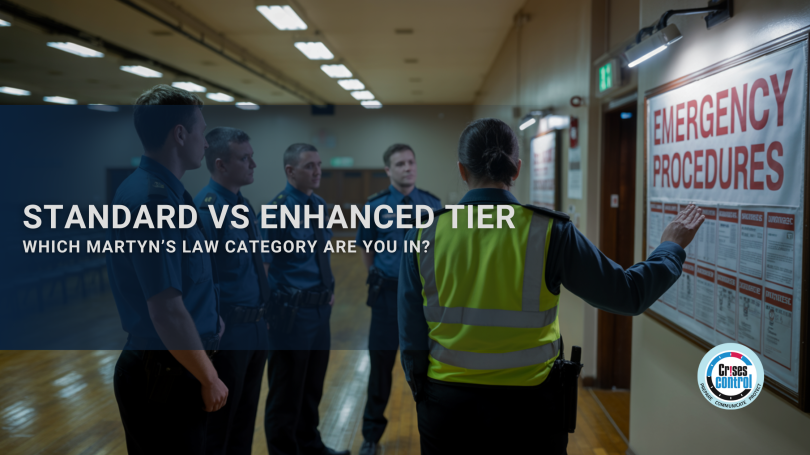Written by Anneri Fourie | Crises Control Executive
What Martyn’s Law Means for Your Venue
The UK now has a legal requirement for venues to prepare for potential terrorist threats. That means whether you run a theatre, church, stadium or a local event space, you may need to take specific steps to improve safety. This new responsibility comes from the Terrorism (Protection of Premises) Act 2025 – more commonly known as Martyn’s Law.
The law was introduced following the Manchester Arena attack in 2017, in memory of Martyn Hett and the other victims. It’s designed to ensure public spaces have sensible plans in place to protect people during a terrorist incident. But one of the biggest questions for venue owners and operators is: what do I actually need to do?
That depends on which tier your venue falls into. Martyn’s Law splits premises into two categories – Standard Tier and Enhanced Tier – based on size and footfall. Each has its own set of requirements. In this article, we’ll explain how the tiers work, what each one involves, and how to work out which category applies to you. We’ll also look at how Crises Control can help you stay compliant without adding complexity.
What Is Martyn’s Law and Why Does It Matter?
Martyn’s Law is now a legal requirement for certain public venues across the UK. It aims to make sure that anyone responsible for a venue or public event has plans in place to reduce the impact of a terrorist attack.
Instead of applying the same rules to every location, the law uses a tiered approach. This way, a small community centre isn’t expected to meet the same standards as a national stadium. The idea is to make protection proportionate, realistic and achievable.
At the core of the law is one principle: preparation saves lives. Whether your venue is large or small, having trained staff, a plan of action and clear procedures can make a crucial difference during a crisis.
Martyn’s Law Tiers: Standard vs Enhanced
Let’s break down what each tier means and what it involves.
Standard Tier: For Venues With 200 to 799 People
If your premises can hold between 200 and 799 people at any one time, you’re likely to be classed as Standard Tier. This includes venues like:
- Community halls
- Local churches and mosques
- Medium-sized function spaces
- Independent cinemas or clubs
- Small to mid-sized music venues
Key Requirements for Standard Tier Venues:
- Create and document basic public safety procedures
- Train staff to spot and respond to suspicious behaviour
- Put together plans for lockdown, evacuation and invacuation
- Assign responsibilities for emergency response
- Keep documentation available for inspection
You don’t need to install expensive technology or undertake formal risk assessments, but you do need a clear plan and to make sure your staff know what to do.
Why it matters:
Small venues are sometimes wrongly seen as low-risk. In fact, their more relaxed security can make them vulnerable. Martyn’s Law makes sure even modest premises are prepared without being overburdened.
Enhanced Tier: For Venues With 800+ People
If your premises can host 800 or more people at once, you fall under the Enhanced Tier. This applies to large venues such as:
- Stadiums and arenas
- Major event spaces
- Shopping centres
- Large theatres or concert halls
- University campuses
Enhanced Tier Requirements Include:
- Formal and thorough terrorism risk assessments
- Advanced security measures like CCTV and controlled access
- Scenario-based training for staff
- Senior-level accountability for compliance
- Regular reviews and testing of security plans
- Systems to manage incidents and share intelligence
Why it matters:
Larger venues are likely to be higher-profile targets. Failures in planning could lead to widespread harm. That’s why the legal duties for Enhanced Tier sites are more demanding.
How to Work Out Your Tier
Many businesses are unsure about which category they fall into. The law defines this based on expected capacity, not just actual attendance. Here’s how to assess your tier.
Key Questions to Ask:
- What’s your venue’s maximum capacity at any one time?
- Do you ever host one-off events that exceed your usual footfall?
- Is your space open to the general public or access-controlled?
- How often do you host events or gatherings?
Even if your venue is usually Standard Tier, a temporary event that attracts over 800 people may require Enhanced Tier compliance for that period.
To make this easier, use the table below to help you self-categorise:
| Criteria | Standard Tier | Enhanced Tier |
|---|---|---|
| Expected footfall | 200–799 | 800+ |
| Venue type | Community halls, churches | Arenas, shopping centres |
| Frequency of large events | Occasional or small scale | Regular or large scale |
| Public access | Controlled or limited | Open and unrestricted |
| Staff roles | Basic frontline duties | Dedicated security personnel |
Keeping accurate records of attendance and capacity can help you justify your classification and stay on the right side of the law.
What Happens If You Don’t Comply?
The law comes with a 24-month implementation period, but enforcement will follow. The Security Industry Authority (SIA) is responsible for ensuring compliance.
Non-compliance could result in:
- Fines or legal notices
- Criminal charges in severe cases
- Loss of permission to hold events
- Reputational damage
- Increased scrutiny from insurers and regulators
It’s worth stressing: this isn’t just about ticking boxes. It’s about being ready to respond when lives are on the line.
Using Software to Make Compliance Simpler
Managing Martyn’s Law requirements manually can be time-consuming, especially across multiple sites. That’s where compliance management software becomes useful.
Crises Control helps organisations put the right procedures in place quickly and consistently. With our platform, you can:
- Digitise and store all public safety plans
- Build clear evacuation and lockdown workflows
- Track staff training and completion
- Set up real-time communication channels for emergencies
- Maintain an audit trail for inspections and reviews
For smaller venues, our tools provide easy-to-follow templates and training resources. For Enhanced Tier venues, we support complex risk assessments, incident response simulations and integrations with existing security systems.
Interested in our Ping Mass Notification Software?
Efficiently alert everyone in seconds at scale with our Mass Notification Software – PING, get the message out fast and ensure rapid response and recovery.

Tailored Support for Your Tier
No two venues are the same. That’s why our platform adapts to different operational needs. Here’s how Crises Control supports both tiers:
Standard Tier:
- Ready-made templates for safety procedures
- Mobile-friendly communication tools
- Checklists for self-auditing
- Simple dashboard to track compliance
Enhanced Tier:
- Custom-built response plans based on formal risk assessments
- Integration with surveillance and access control systems
- Scenario-based training modules
- Centralised reporting and audit tools for senior managers
Whether you need basic guidance or enterprise-grade tools, Crises Control gives you control and confidence when it comes to security and compliance.
Preparing Now Means Protecting Lives Later
The Martyn’s Law tier system makes it easier to understand what you need to do, but taking action is still up to you. By starting now, you can meet the legal requirements before enforcement begins, and more importantly, you can make your venue a safer place for everyone.
Having the right systems and knowledge in place means that if the worst happens, you won’t be caught off guard.
Conclusion: Get Help Categorising Your Venue and Preparing for Martyn’s Law
There’s no benefit in waiting. Whether you’re running a 300-person hall or a 10,000-seat stadium, Martyn’s Law asks you to take your duty of care seriously.
Crises Control helps you turn that obligation into practical action. From risk assessment to response plans, from staff training to incident alerts, we give you the tools to prepare effectively.
Ready to take the next step?
Contact us to book a free demo and find out how Crises Control can support your journey towards full Martyn’s Law compliance.
Request a FREE Demo

